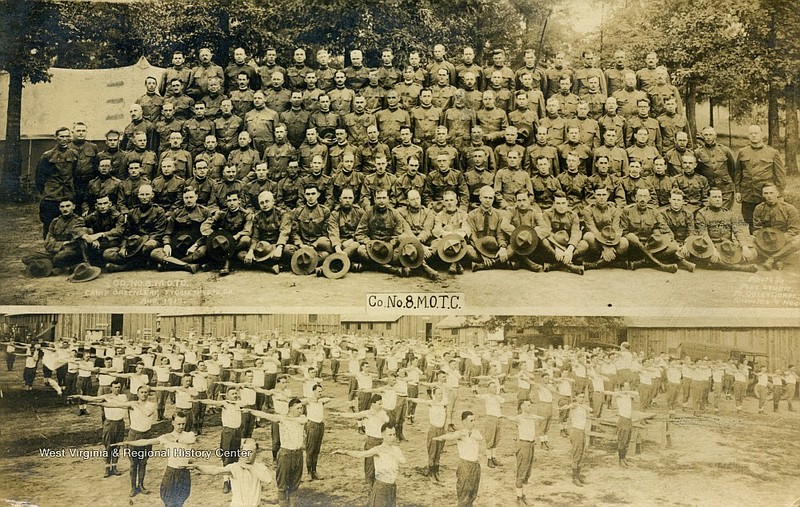While Chattanooga was mourning the deaths of its sons on the Western Front during the German spring offensive of 1918, a call once again came from Washington, D.C., for a "replenishing of the nation's war chest." C.C. Nottingham stepped forward as zone chairman, while W.M. Elliott signed on as Hamilton County chairman. Together they organized an army of volunteers committed to raise an additional $3 million in Liberty Bonds.
Quickly planning a "big parade" on the first anniversary of the United States' entrance into the war, the volunteers mounted a spectacular event that drew thousands of flag-waving citizens to the parade route as they cheered on the "Yanks." Hundreds of soldiers in training at Fort Oglethorpe, members of men's and women's organizations, church youth groups and students representing public and private high schools followed the five grand marshals - Judge Bachman, Judge Garvin, Judge Cummings, Judge McReynolds and Sam Connor - who marched carrying a large horizontal U.S. flag. The celebration continued long after the parade had ended with spontaneous parades in neighborhoods across the county.
Two weeks later, on April 26, Hamilton County declared another Liberty Day and sponsored a series of crowd-pleasing events. Once again, Chattanooga hosted a parade. More than 15,000 school children marched the parade route, 10 students across, as the column stretched for blocks. The parade snaked through the city as family members and other citizens cheered, often throwing confetti and holding high photos of "their soldiers." That afternoon, a mock battled was staged at Warner Park, ending with an Allied victory, followed by drill exhibitions from both soldiers in training and student groups. At sunset, the local Elks lit up the sky with a fireworks display that "awed young and old alike." When the month ended, Chattanooga had once again oversubscribed its quota and had raised more than $4 million.
On June 27, 1918, the city came alive to celebrate Camp Gordon soldiers "shipping out" from Union Station. In a sign of unity and support for the U.S. Army troops, Confederate and Union veterans linked arms and stepped in to lead the soldiers as they drew close to the station. Among the veterans marching were L.T. Dickinson, Capt. J.F. Shipp, Dr. T.L. Abernathy, Capt. A.J. Gabagan and Col. D.M. Steward. The Elks and other organizations followed the soldiers. Factory whistles blared, and local bands coordinated in playing "Pack Up Your Troubles in Your Old Kit Bag and Smile, Smile, Smile." Bouquets of flowers were tossed toward the soldiers, and the crowd waved not only U.S. flags but flags of the Allied nations. According to a local newspaper, "no color line was drawn in these demonstrations; equal acclaim being accorded the negro troops as they marched away to war." Patriotic fever swelled the crowd.
Patriotism in Chattanooga reached a new zenith on Sept. 12, 1918, deemed as Registration Day, when the announcement reached the city that the draft age had been extended to 45 years. For weeks, the newspapers had printed the casualty numbers from the region, state and nation; a sense of urgency had arisen among citizens. Many remembered President Wilson's call to "make the world safe for democracy" and worried that the tide might turn in favor of the Axis powers. About 13,000 local men responded, joined by additional recruits arriving in Chattanooga to march south for training. While all the camps expanded, the number training in the medical corps increased so significantly that by late September, Camp Greenleaf, as the doctors' quarters were called, "had grown to the largest medical university in the world."
Within six weeks, an armistice was announced. As the Chattanooga Times later reported, "Who of those who witnessed them can ever forget the scenes on Chattanooga's streets when, on that memorable early morning of November 11, a great bomb fired from the roof of the Times Building, and repeated a second later from the Hotel Patten, gave the joyous and thrilling signal that the armistice had been signed - that the war was really over!" Market Street filled with shouting crowds, "giving themselves up to unrestrained joy ... ."
Once the intoxication of victory had subsided, citizens across the city quietly gathered in their churches and synagogues to remember those who had died, recognizing the cost of victory - the cost of freedom.
Linda Moss Mines, the Chattanooga and Hamilton County historian, is regent, Chief John Ross Chapter, NSDAR, and vice-president of Charles H. Coolidge National Medal of Honor Heritage Center.
